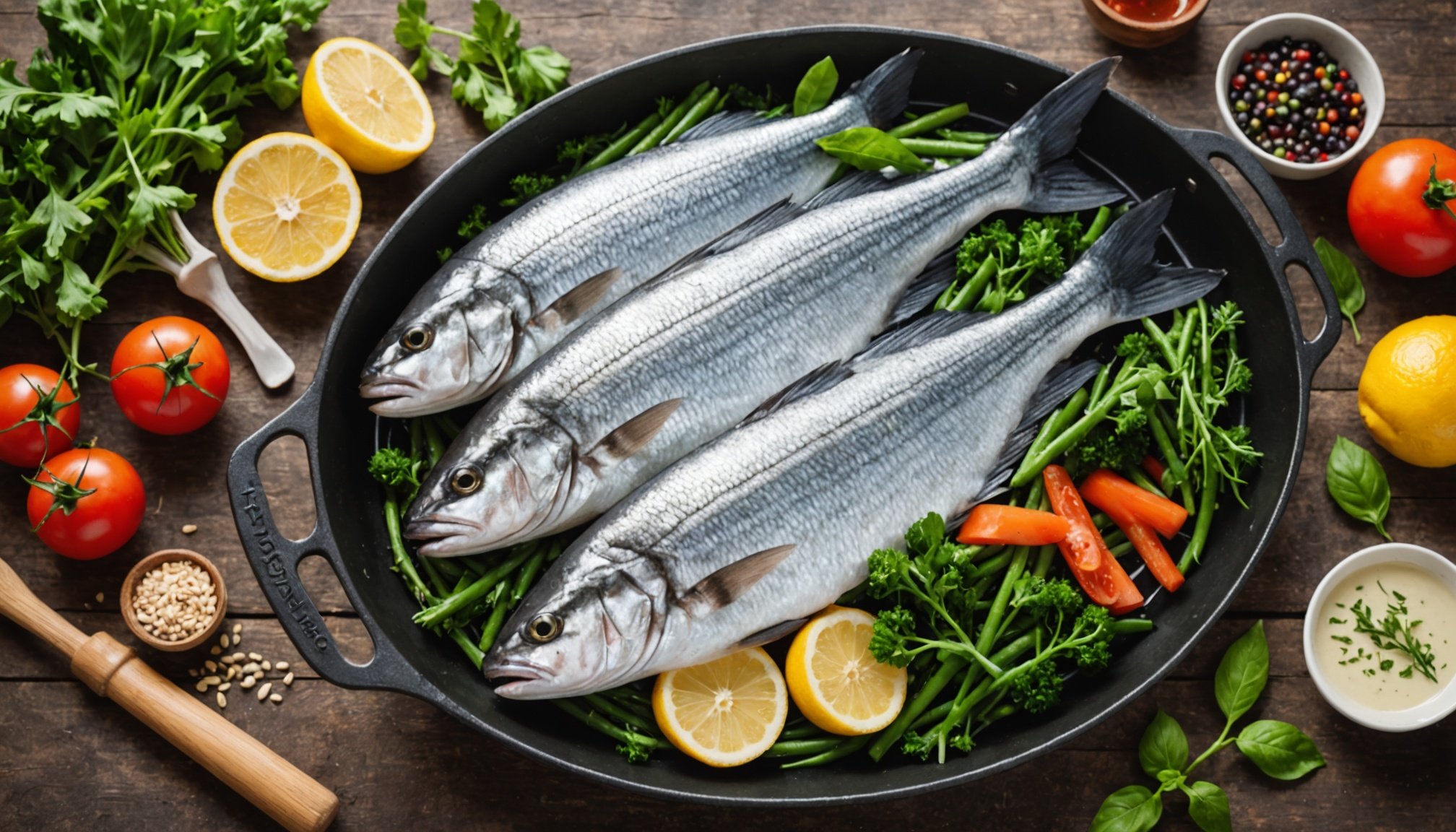Selecting a fish poacher goes beyond mere functionality; it’s about enhancing your culinary experience while prioritizing health. The right poacher elevates flavors, preserves nutrients, and simplifies cooking. This guide equips health-conscious culinary enthusiasts with essential insights on key features, materials, and techniques to consider. Whether you're a novice or a seasoned chef, making an informed choice enables you to prepare delicate fish dishes effortlessly and encourage a healthier lifestyle.
Understanding Fish Poaching
Delving into the art of fish poaching reveals a cooking technique that is both gentle and effective. Unlike frying or grilling, poaching involves simmering fish in a liquid, such as broth or wine, at a low temperature. This method ensures the fish remains tender and moist, preserving its natural flavors and nutrients.
In parallel : Essential Features to Look for in a UK Dishwasher for Maximum Energy Efficiency
Health Benefits of Poaching Fish
By choosing poaching over other cooking methods, you can enjoy numerous health benefits. Poaching requires minimal to no added fats, making it a heart-healthy choice. It also helps retain the fish's omega-3 fatty acids, which are essential for maintaining cardiovascular health. Furthermore, the gentle cooking process minimizes the formation of harmful compounds that can occur at higher temperatures.
Essential Equipment for Successful Fish Poaching
To master fish poaching, certain equipment is indispensable. A wide, shallow pan allows for even cooking, while a thermometer ensures the liquid remains at the ideal temperature. A slotted spoon is useful for gently removing the fish without breaking it apart. Here’s a quick checklist:
Also read : Essential food processor products and accessories you need now
- Wide, shallow pan
- Cooking thermometer
- Slotted spoon
Incorporating these tools and techniques can elevate your culinary skills, allowing you to enjoy the full spectrum of flavors and health benefits that poaching has to offer.
Types of Fish Poachers
Exploring the various types of fish poachers can enhance your cooking experience by providing tools that suit different needs and preferences.
Traditional vs. Modern Fish Poachers
Understanding the evolution of fish poaching equipment.
Traditional fish poachers, often made from stainless steel, offer a classic approach to poaching. They typically include a rack and lid, ideal for stovetop use. In contrast, modern poachers may incorporate non-stick surfaces and even digital temperature controls, aligning with contemporary culinary trends.
Stovetop Poachers vs. Oven Poachers
Choosing the right poacher for your cooking method.
Stovetop poachers are versatile and allow for precise temperature adjustments, making them perfect for delicate fish. Oven poachers, however, provide uniform heat distribution and can accommodate larger portions. Selecting between these styles depends on your cooking setup and the type of fish you prefer.
Specialty Poachers for Different Types of Fish
Tailoring your equipment to specific fish varieties.
Certain fish, like salmon or trout, might benefit from specialty poachers designed to enhance their unique flavors and textures. These poachers often come with specific features, such as curved racks or adjustable trays, ensuring optimal results.
- Traditional Poachers
- Modern Poachers
- Stovetop Poachers
- Oven Poachers
- Specialty Poachers
By understanding the types of fish poachers, you can make informed decisions that elevate your culinary endeavors.
Features to Consider When Choosing a Fish Poacher
Selecting the right poacher can enhance your culinary experience.
Material Matters
The material of a fish poacher significantly impacts its cooking performance. Stainless steel is durable and offers even heat distribution, ensuring consistent results. Non-stick surfaces, on the other hand, simplify cleaning and prevent fish from sticking, preserving delicate textures.
Size and Cooking Needs
When choosing a fish poacher, size is crucial. Consider your typical serving size and cooking needs. A larger poacher accommodates bigger fish or multiple servings, enhancing versatility. Conversely, a smaller poacher is ideal for compact kitchens and individual meals.
Versatility in Cooking Techniques
A versatile poacher supports various cooking techniques, from stovetop simmering to oven baking. Look for features like adjustable racks or removable trays that allow you to tailor the poacher to different types of fish. This adaptability ensures the poacher complements your culinary approach.
Key Features Checklist
- Material: Stainless steel or non-stick
- Size: Suitable for your cooking needs
- Versatility: Supports multiple cooking techniques
By understanding these features, you can make informed decisions when choosing a fish poacher, optimizing your cooking performance and enhancing your culinary creations.
Health Benefits of Poaching Fish
Exploring the nutritional benefits and advantages of poached fish.
Nutritional Advantages of Poached Fish
Poaching fish offers significant health benefits by preserving its natural nutrients. Unlike frying or grilling, which can degrade essential nutrients, poaching maintains the fish's vitamins and minerals. Poached fish nutrition is particularly rich in omega-3 fatty acids, crucial for heart health and brain function.
Poaching vs. Frying and Grilling
When comparing cooking methods, poaching stands out for its ability to retain moisture and flavor. Frying often involves added fats, which can increase calorie content and diminish nutritional value. Grilling, while healthier than frying, can still lead to nutrient loss at high temperatures. In contrast, poaching uses gentle heat, making it an ideal method for those seeking the full health benefits of fish.
Preserving Moisture and Flavor
The poaching technique ensures that fish remains tender and flavorful. By cooking at low temperatures, it prevents the drying out that can occur with other methods. This moisture retention not only enhances taste but also contributes to the overall health benefits of poaching, as it avoids the formation of harmful compounds.
- Poached fish nutrition
- Health benefits of fish
- Cooking health benefits
Incorporating poaching into your culinary repertoire can elevate both the nutritional value and taste of your meals.
Maintenance and Care for Fish Poachers
Ensuring the longevity and performance of your fish poacher.
Best Practices for Cleaning
Proper fish poacher maintenance is crucial for extending its lifespan. After each use, allow the poacher to cool before cleaning. Use warm, soapy water and a soft sponge to avoid scratching. For stubborn residues, a mixture of baking soda and water can be effective. Avoid using abrasive pads that can damage non-stick surfaces.
Avoiding Damage to Non-Stick Surfaces
To protect the non-stick surfaces of your fish poacher, never use metal utensils. Opt for silicone or wooden tools to prevent scratching. When storing, ensure the poacher is completely dry to avoid moisture damage. Stack with care, placing a soft cloth or paper towel between items to prevent surface contact.
Tips for Extending Lifespan
Regular maintenance and proper handling are key to the longevity of your cookware. Inspect your poacher periodically for signs of wear or damage. If the non-stick coating begins to peel, it's time to replace it. Consistent care not only extends the life of your poacher but also ensures optimal cooking performance.
- Use soft sponges for cleaning
- Avoid metal utensils to protect surfaces
- Inspect regularly for signs of wear
By following these tips, you can maintain your fish poacher in excellent condition, ensuring it remains a reliable tool in your kitchen.
Product Recommendations for Fish Poachers
Exploring the market for best fish poachers unveils options that suit various cooking needs and budgets.
Top-Rated Fish Poachers
Selecting the right poacher can enhance your culinary experience. Among the top-rated fish poachers, several brands stand out for their quality and performance. These products are praised for their durability, ease of use, and versatility.
Comparison of Features and Pricing
When considering product reviews, it's essential to compare features and pricing. Some popular brands offer stainless steel models with adjustable racks, while others provide non-stick surfaces for easy cleaning. Here's a quick comparison:
| Brand | Material | Price Range | Notable Feature |
|---|---|---|---|
| Brand A | Stainless Steel | $$ | Adjustable Racks |
| Brand B | Non-stick | $$$ | Digital Controls |
| Brand C | Aluminum | $ | Lightweight Design |
User Reviews and Insights
User reviews offer valuable insights into the performance of these poachers. Many users appreciate the even heat distribution and ease of cleaning. However, some note that digital controls can be complex for beginners. Overall, these recommended brands are favored for their reliability and functionality.
By considering these factors, you can make an informed decision, ensuring your chosen poacher meets your needs and enhances your cooking endeavors.
Recipes for Poaching Fish
Exploring simple and advanced methods for delicious poached fish dishes.
Simple Poaching Recipes for Beginners
Starting with simple poaching recipes can ease you into the art of fish poaching. Begin by selecting a mild-flavored fish like cod or tilapia. Simmer in a basic broth of water, lemon slices, and herbs for a light, healthy dish. This approach allows you to master the cooking techniques while enjoying a nutritious meal.
Flavorful Broth Ideas for Poaching Fish
Enhance your poached fish with flavorful broth ideas. Consider using a mix of white wine, vegetable stock, and fresh dill to infuse the fish with rich flavors. Adding garlic and ginger can provide an aromatic twist. These broths elevate your fish poaching recipes, transforming simple dishes into gourmet experiences.
Advanced Techniques for Gourmet Poached Fish Dishes
For those ready to explore advanced techniques, try poaching salmon in a miso-infused broth. This method requires precision to maintain the fish's delicate texture and flavor. Another option is to use a court-bouillon, a seasoned liquid that enhances the fish's natural taste. Experimenting with these techniques can result in exquisite, healthy fish dishes.
- Simple poaching recipes
- Flavorful broth ideas
- Advanced techniques
By incorporating these methods, you can create diverse and delicious fish poaching recipes that cater to various tastes and skill levels.
User Experiences and Reviews
Exploring insights from actual users can be invaluable.
Summary of User Experiences
Fish poacher user reviews reveal a diverse range of experiences. Many customers appreciate the ease of use and even heat distribution provided by modern poachers. Users frequently highlight the durability of stainless steel models and the convenience of non-stick surfaces. However, some feedback indicates that digital controls can be challenging for beginners.
Common Praises and Complaints
Customer feedback often praises the versatility of fish poachers, particularly those with adjustable racks and removable trays. Users find these features enhance their cooking experiences by accommodating various fish types. Common complaints include the complexity of digital settings and the occasional difficulty in cleaning certain models.
How Reviews Guide Purchasing Decisions
Fish poacher user reviews serve as a guide for potential buyers. By understanding the common praises and complaints, consumers can make informed decisions. Reviews highlighting ease of cleaning or cooking performance can steer buyers towards poachers that align with their preferences.
- Ease of use and even heat distribution
- Durability of stainless steel
- Versatility with adjustable racks
Customer feedback is a crucial resource, offering insights that help navigate the diverse options available in the market.
Comparing Poaching Techniques
Exploring diverse methods for effective fish poaching.
Water, Broth, and Wine Poaching
Different poaching techniques offer unique benefits and flavors. Water poaching is simple, ideal for delicate fish like sole, as it maintains the fish's natural taste. Broth poaching adds depth, using vegetable or fish stock to enhance flavors, perfect for heartier types like cod. Wine poaching infuses an aromatic quality, often paired with salmon or trout, providing a sophisticated touch.
Choosing the Best Technique
Selecting the right poaching technique depends on the fish type and desired outcome. For a subtle taste, opt for water. To enrich the fish's flavor, choose broth. For a gourmet experience, wine is the best choice. Consider the fish's texture and flavor profile when deciding, ensuring the method complements the natural qualities.
Timing and Temperature Insights
Effective poaching techniques require precise timing and temperature control. Maintain a gentle simmer, avoiding a rolling boil, to prevent the fish from becoming tough. Use a thermometer to keep the liquid between 160-180°F (71-82°C). Timing varies with fish thickness; generally, allow 10 minutes per inch of thickness for optimal results.
- Water poaching: Subtle flavors
- Broth poaching: Enhanced taste
- Wine poaching: Aromatic infusion
By mastering these methods, you can elevate your fish poaching skills and enjoy a variety of delicious dishes.
Conclusion and Future Trends in Fish Cooking
Exploring the evolving landscape of fish cooking techniques and equipment.
Emerging Trends in Healthy Cooking Techniques
In the future of fish cooking, health-conscious culinary practices are gaining momentum. Emerging trends focus on methods that preserve nutrients while enhancing flavors. Techniques like sous-vide and steam poaching are becoming popular for their ability to maintain moisture and nutrients. These methods align with the growing demand for healthy, flavorful dishes.
Innovations in Fish Cooking Equipment
Innovation in cooking equipment is transforming how we prepare fish. Modern gadgets, such as digital poachers and precision cookers, offer enhanced control over cooking temperatures, ensuring perfect results every time. These advancements cater to both amateur cooks and professional chefs, making sophisticated techniques more accessible.
The Future of Health-Conscious Culinary Practices
The future of fish cooking is set to embrace technology and sustainability. Eco-friendly materials and energy-efficient appliances are becoming standard, reflecting a shift towards sustainable cooking practices. As consumers become more health-conscious, the integration of smart technology into cooking equipment will likely continue, offering personalized cooking experiences.
- Sous-vide and steam poaching
- Digital poachers and precision cookers
- Eco-friendly materials in equipment
By staying informed about these culinary trends, you can adapt your cooking practices to meet evolving dietary preferences and technological advancements.













